A groundbreaking ceremony and press conference was held in the connector building between the two piers on Tuesday morning. But instead of shovels digging into ground, the Exploratorium lowered a diver into the bay waters from a barge stationed behind the piers. As the crowd of guests, including groups of school children, looked on from behind barricades a few yards from the end of the pier, the Green Street Band from San Francisco launched into old-time jazz staples such as “Tiger Rag”, “Wabash Blues” and a version of “You Are My Sunshine.”
The diver emerged a few minutes later, hoisted from a crane, standing inside and holding onto a black metal hoop. The hoop was then given to Dennis Bartels, Exploratorium’s Executive Director, and George Cogan, chairman of the museum’s board of directors. They climbed two ladders and placed the “O”-shaped hoop between the remaining letters of the museum’s name which was written on the white wall of the building facing onto the Bay.
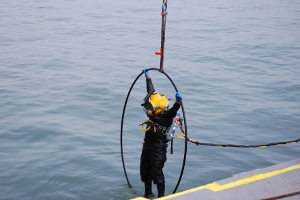 Exploratorium diver emerges from the Bay, holding onto a hoop.(Credit: Sheraz Sadiq)
Exploratorium diver emerges from the Bay, holding onto a hoop.(Credit: Sheraz Sadiq)
Officials from the Exploratorium, David Chiu of the San Francisco Board of Supervisors and Rodney Fong of the San Francisco Port Commission spoke afterward about the significance of the Exploratorium’s relocation to the waterfront, as well as the economic boon for San Francisco with the creation of 900 new jobs during construction of the project over the next two years.
“We finally get to play outdoors. Instead of shrinking nature down to fit onto a tabletop, which we’ve done for so many years, we get to now go play with Mother Nature itself, which is really fabulous,” said Bartels.
The cost for the new museum – which is scheduled to open in 2013 – and the rehabilitation of Pier 15, which marks the first phase of the project, is estimated at $220 million. Construction of the new museum will first require the seismic upgrading and renovation of Piers 15 and 17, which were built respectively in 1931 and 1912.
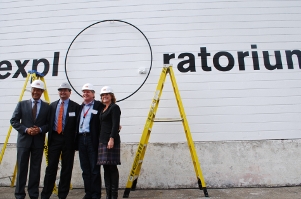 From Left to Right, Rodney Fong (SF Port Commission), George Cogan (Exploratorium), Dennis Bartels (Exploratorium), Monique Moyer (SF Port Commission). (Credit: Sheraz Sadiq)
From Left to Right, Rodney Fong (SF Port Commission), George Cogan (Exploratorium), Dennis Bartels (Exploratorium), Monique Moyer (SF Port Commission). (Credit: Sheraz Sadiq)
At the groundbreaking event, the Exploratorium officially launched its $300 million capital fundraising campaign, with $209 million raised thus far. In March, the museum announced it received two anonymous donations from Bay Area high-tech leaders totaling $90 million, provided that they raise an additional $40 million from other sources. The donations are the largest the museum has received since its founding in 1969.
The project received a permit in March from the Bay Conservation and Development Commission which required the museum to mitigate for the environmental impact of the new construction and the dredging and hauling of nearly 75,000 cubic yards of mud from the Bay, which has already begun.
“The San Francisco waterfront is easy to get to and it has all around it the natural beauty and everything that the Exploratorium is all about. So it adds to the excitement,” said Will Travis, executive director of the Bay Conservation and Development Commission, known as BCDC. “It will take what is now a treasure in the region and make it an international phenomenon.”
For years, the museum has looked at alternative sites to accommodate the more than 500,000 visitors who annually pass through its doors and to boost its renowned professional development workshops for science educators. The Exploratorium’s new campus at the piers will be the length of a New York City block and nearly five times larger than its current space. Its managers also expect a doubling in the museum’s attendance, given the proximity to public transit at the waterfront.
The project represents another major boost for fans of Bay Area science and environmental education, coming two years after completion of the new California Academy of Sciences museum in Golden Gate Park, which opened in September 2008.
The San Francisco real estate investment and development firm, Wilson Meany Sullivan, which played a key part in the redevelopment of the Embarcadero Ferry Building, has been hired by the Exploratorium to oversee development of the new museum, which Dennis Bartels, the Exploratorium’s Executive Director, claimed would be “the first neutral energy museum in the world.”
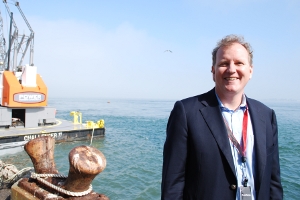 Exploratorium Executive Director Dennis Bartels. (Credit: Sheraz Sadiq)
Exploratorium Executive Director Dennis Bartels. (Credit: Sheraz Sadiq)
“The building has a long roofline and because of that we can generate 1.4 megawatts of solar power with today’s technology, and we’re putting in other sustainability measures. The constant temperature of the Bay can actually be set up to a heat exchanger so that we can get both heat and cooling right out of the water through a radiant floor system,” said Bartels.
The new space will boast a 32-foot observatory with a rooftop “Outdoor Learning Center”, indoor and outdoor exhibits, a courtyard, a tidal pool, a restaurant and café, as well as a “Bayside History Walk” at each of the two piers which will feature interpretive exhibits of San Francisco’s maritime history. An asphalt parking lot between the two piers will be removed, exposing the waters of the Bay below, traversed via two pedestrian bridges.
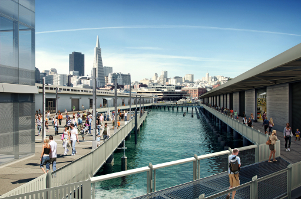 llustration of the exposed Bay between Piers 15 and 17 with connecting pedestrian bridges. (Credit: ZUM)
llustration of the exposed Bay between Piers 15 and 17 with connecting pedestrian bridges. (Credit: ZUM)
According to Travis, BCDC’s executive director, the agency was impressed with the more than two acres of public access that will be created by the Exploratorium at Piers 15 and 17.
The design plans call for outdoor public access along all sides of the new museum and nearly 800 square feet of indoor public access on the second floor of the new observatory building.
“Because it's inside, it will be open at all times during the year and nobody has every done this before,” Travis said. “It’s like taking an executive's office, the most valuable part of the project, and dedicating it to the public. That's way cool.”
The Exploratorium was the brainchild of Frank Oppenheimer, a physicist and the younger sibling of atomic bomb developer Robert Oppenheimer. The museum encourages adults and children to play with its nearly 500 on-site exhibits, artworks and displays, fostering an environment where fun is a prerequisite to learning about science, whether it’s DNA or the Doppler Effect.
“The Exploratorium helps educate a science literate society. And we need that,” said Sue Pritchard, a former head of the California Science Teachers Association who teaches middle school students at a public school in Orange County.
Oppenheimer served as the museum’s director from its opening in 1969 to his death in 1985. He also designed many of the museum’s exhibits, including one located roughly 100 feet from the front door which features rubber balls that start bouncing in a transparent chamber when a dial is turned by museum patrons.
“This is an exhibit that can entrance a four-year-old or a physics professor,” said Paul Doherty, co-director of the Teacher Institute at the Exploratorium. “It teaches that when a gas gets hotter, the molecules of the gas move more quickly, on average. And some of the molecules move really fast and some of the molecules move slowly.”
Since 1984, the Exploratorium has offered training to science teachers from around the world through its National Science Foundation-supported Teacher Institute. One hundred teachers are accepted to participate in its summer program, where for one month, six hours a day, five days a week, teachers learn how to build scaled-down versions of Exploratorium exhibits they can use in their classrooms. In 2009, the institute offered a toy workshop to teachers, showing them, for example, how to build tugboats of aluminum baking pans to help foster classroom discussions about force and motion.
“This is the power of the Exploratorium. It gets the students' minds thinking. Thinking, sharing and doing,” said Pritchard, who has attended the Exploratorium’s Summer Institute six times since 1998.
“It caused me to totally change how I teach science,” she added. “I realize textbooks have their place but there’s so much more to teaching science. And when you have no money coming in to support science, you appreciate knowing the inexpensive ways to enlighten the students and to bring to the classroom this excitement and passion for science.”
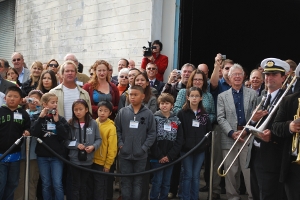 Crowd behind Piers 15 and 17 at the groundbreaking event for the new Exploratorium. (Credit: Sheraz Sadiq)
Crowd behind Piers 15 and 17 at the groundbreaking event for the new Exploratorium. (Credit: Sheraz Sadiq)
For Doherty, the Exploratorium’s move to the waterfront piers marks an exciting period of growth for the Teacher Institute, which currently must turn away two out of every three applicants for lack of space.
“We may now be able to accommodate 120 teachers during the summer and maybe see a 30 percent increase in our physical space for the Teacher Institute,” he said. “In the new Exploratorium, we’ll be doubling the number of classrooms and there will be entirely new programs that use those classrooms.”
Since 2004, the Exploratorium has been working with the Port of San Francisco to negotiate a 66-year lease and development agreement for its use of 136,000 square feet at Pier 15 and 110,000 square feet at Pier 17.
In 2005, the San Francisco Board of Supervisors passed a resolution that exempted the museum’s lease of the piers from San Francisco’s competitive bidding process because of its “uniqueness as a special cultural and educational opportunity for the people of the City and County of San Francisco.” Supervisors approved the project last November.
When asked what founder Frank Oppenheimer would think about the Exploratorium’s future home, Bartels said, “He would be so proud. He was the one who said that the Exploratorium is never finished. So he believed it was always an act of creation, always a process of changing itself and trying on new things and always experimenting. And to have this kind of site to do our experiments, just to see the excitement in our staff, to see that would have made him grin from ear to ear.”
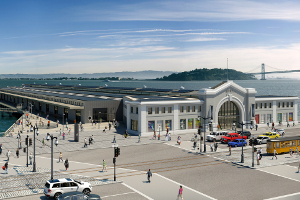 Illustration of the Exploratorium's future home at Pier 15. (Credit: ZUM)
Illustration of the Exploratorium's future home at Pier 15. (Credit: ZUM)




